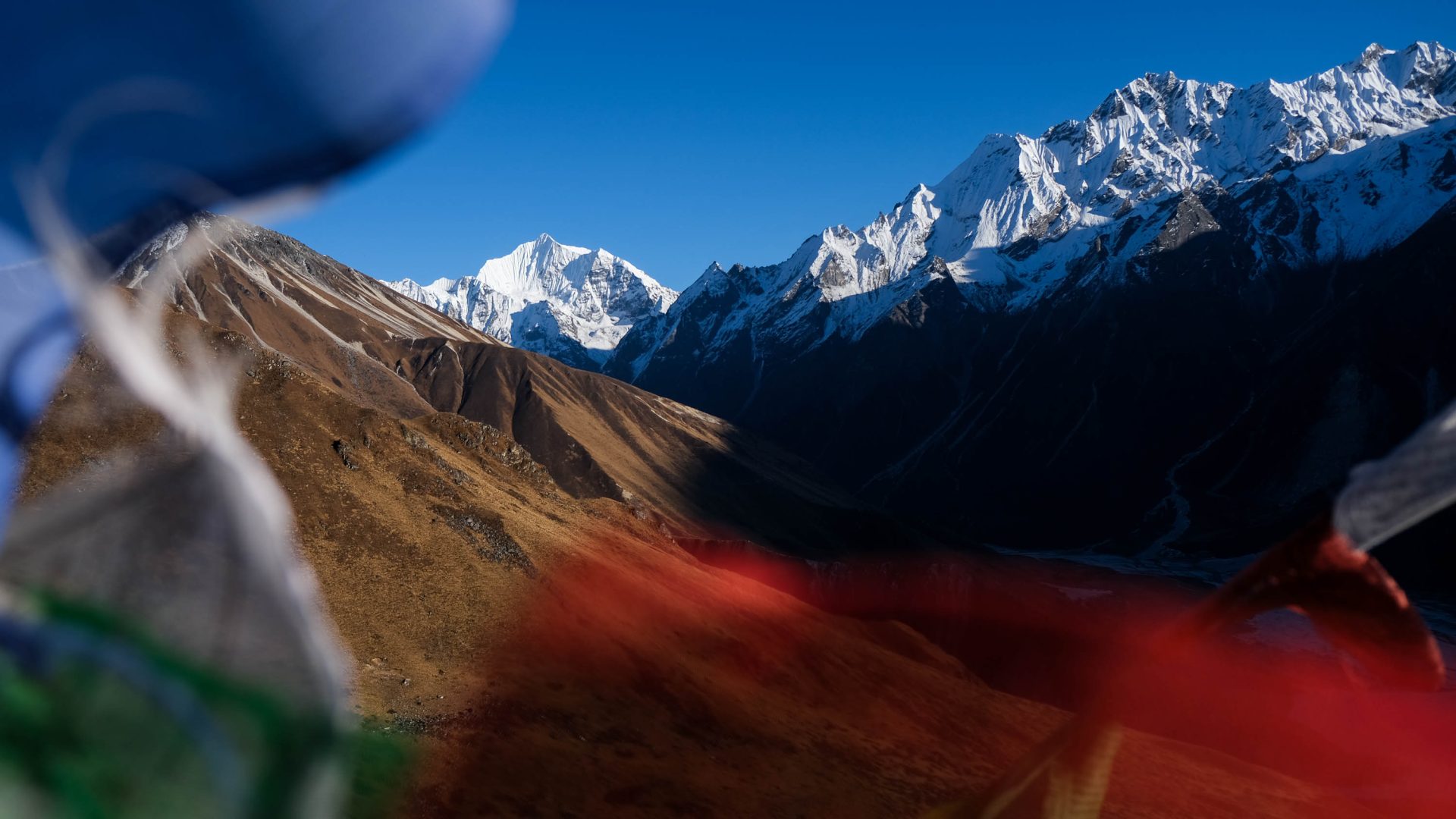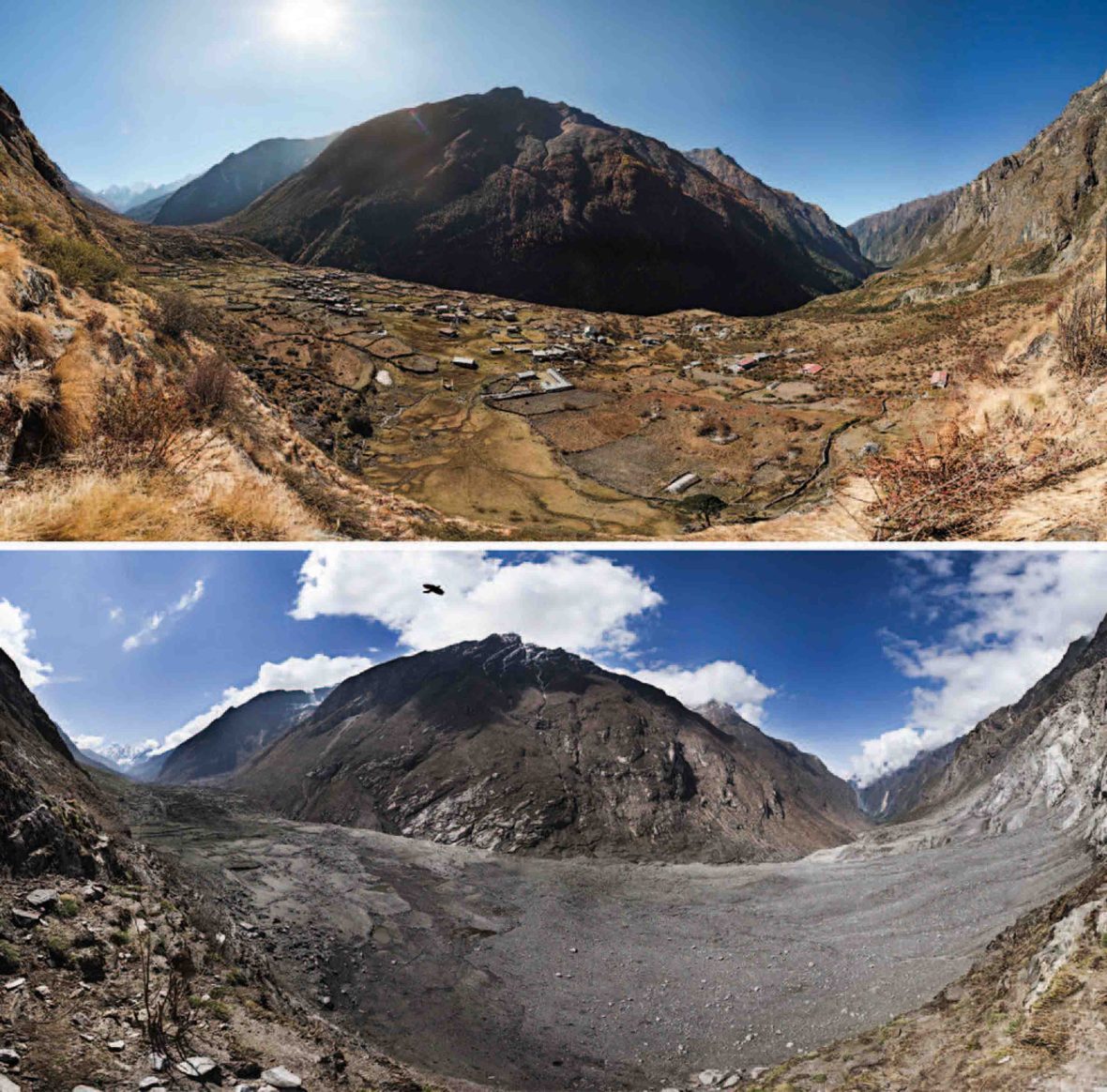
Research scientist and travel writer Tsewang Nuru Sherpa takes on Nepal’s Langtang Trek eight years after a massive earthquake and avalanche destroyed the region. What he finds is a lesson in resilience.


Research scientist and travel writer Tsewang Nuru Sherpa takes on Nepal’s Langtang Trek eight years after a massive earthquake and avalanche destroyed the region. What he finds is a lesson in resilience.
When you walk up Langtang Valley, one of the many striking things you will see are houses untouched—left behind, forsaken and forgotten. Walk further, and you will cross through a valley where all trees have been uprooted, as if a giant threw a temper tantrum. A river that used to flow from the frozen lake has vanished completely, leaving behind a desolate landscape, and the bridge that once spanned its waters is now buried under the rubble of rocks. These are the reminders of a landslide so devastating it wiped a whole river out of existence, of the 7.8 magnitude earthquake of April 2015, and the following avalanche that crashed down from Langtang Lirung and Langtang II, two of the area’s highest peaks.
It’s almost unbelievable that if you were to venture farther up the valley and make it to Langtang village, it appears that this place never knew disaster. Langtang, a glacial basin in the Himalayas, embodies the qualities that I hold most dear in mountain hamlets: Its remote, rugged, awe-inspiring, and transcendental ambiance. Yaks are everywhere. Women plait their hair. Trekkers en route to Kyanjin Gompa march up the streets. Yak dung fires mix with the thin air at 3,400 meters (11,110 feet). As I stroll around the village, a woman is herding her sheep home under the watchful eye of Langtang’s snow-covered peaks. She stops and squints curiously at me.

Back at our teahouse, the warm kitchen fire ensconces me as Sangay, the owner, brews me a hot salt tea. He recounts the events leading up to the earthquake: “The whole village was gathered at the monastery to celebrate a traditional ceremony of Ghewa to mark the reincarnation of a deceased valley resident,” he says. “Little did we know that this would foreshadow something of this scale.” He is teary-eyed but still smiling. As I look at the heart-wrenching before-and-after image of Langtang in Sangay’s dining room, I couldn’t help but think that Langtang is friendly to visitors but tough on its people.
“The disasters have shown us a wide array of humanity’s immense capabilities—grit, tenacity, perseverance, generosity, and courage.” The qualities have become the essence of Langtang’s heart and soul.”
- Ashish Tamang
The mighty Everest and Annapurna have always overshadowed Langtang. While not as renowned or developed, the infrastructure for solo and independent travelers in this idyllic region is adequate. The Langtang trek‘s proximity to the capital city of Kathmandu—being only 200 kilometers (125 miles) away—plus its budget-friendliness has made it an appealing choice for travelers. Plus, it is one of the few regions in Nepal where treks lasting two weeks or less are feasible.
Langtang has always been renowned for its majestic mountains, sublime natural vistas, diverse flora and fauna, and rich cultural heritage. And ever since the earthquake, this region has gained momentum because of its resiliency and tenacity.
My trek started with an eight-hour ride from Kathmandu to Syaphru Besi, a tranquil town that serves as the gateway to the region’s trail. On the trail, trekkers can experience a mixture of hiking and culture—“It’s like a walking museum,” says one German hiker I run into along the way.
Much of the trail from Syaphru to Kyangjin passes through small hamlets adorned with fragrant rhododendron groves along with chorten, small stupas, or religious monuments that have been carved to commemorate the loss of valley residents during the earthquake.
Langtang village is the largest in the valley; a thriving, functioning community of teahouses sitting in the bowl-shaped valley. Although the mountains are undoubtedly the primary attraction in Langtang, the strong sense of community and the Tibetan culture, which seemed unaffected by Nepalese influence, amused me. For Langtang, the most foundational resource for coping with the devastation has been the network of people around the valley. As Sangay says, “The strength of the bonds among us, as a community, has given us the ability to envision and mend the society we have created.”
My final destination on the trek was Kyangjin (3,755 meters; 12,300 feet), a group of teahouses all clustered amidst the imposing mountains. The trail from Langtang to Kyangjin passes several lengthy prayer wheels and colorful prayer flags fluttering in the wind. High above the Kyangjin valley lie glaciers sparkling in the sunlight, shedding their frozen tears beneath towering peaks. Besides Kyangjin, there are numerous options to explore, from glacial walks to climbing a peak or the Tserko Ri, the highest point in Kyanjin.
I meet Ashish Tamang from Godetabela, a hamlet I had crossed a day before to Langtang, to hike Tserko Ri together. At a staggering 4,984 meters (16,300 feet), most of the climb to the summit involves navigating through rocky terrain. “The disasters have shown us a wide array of humanity’s immense capabilities—grit, tenacity, perseverance, generosity, and courage,” he reflects. Looking down the valley as we rest, he adds, “The qualities have become the essence of Langtang’s heart and soul.”
At the summit of Tserko Ri, you’ll only hear the serene calm around you and the cold, whistling wind. Gazing down the valley to Kyangjin village and beyond the vast stretches further down, you can see how far this region has come since the massive devastation. The wounds are still there from the earthquake. However, like Sangay, Ashish is resilient and optimistic. “Acknowledging our wounds and still rebuilding and reimagining new visions of who we are, or were, and of what we could be, has given us a chance to build back better,” he says.
***
Adventure.com strives to be a low-emissions publication, and we are working to reduce our carbon emissions where possible. Emissions generated by the movements of our staff and contributors are carbon offset through our parent company, Intrepid. You can visit our sustainability page and read our Contributor Impact Guidelines for more information. While we take our commitment to people and planet seriously, we acknowledge that we still have plenty of work to do, and we welcome all feedback and suggestions from our readers. You can contact us anytime at hello@adventure.com. Please allow up to one week for a response.

Tsewang Nuru Sherpa is an environmental scientist specializing in climate change and environmental management. He’s also a travel writer who enjoys writing about outdoor adventure and responsible travel. He usually travels slowly by foot or by bike in the mountains. He is passionate about research and science, but sports and adventure fuel his soul.






Can't find what you're looking for? Try using these tags: